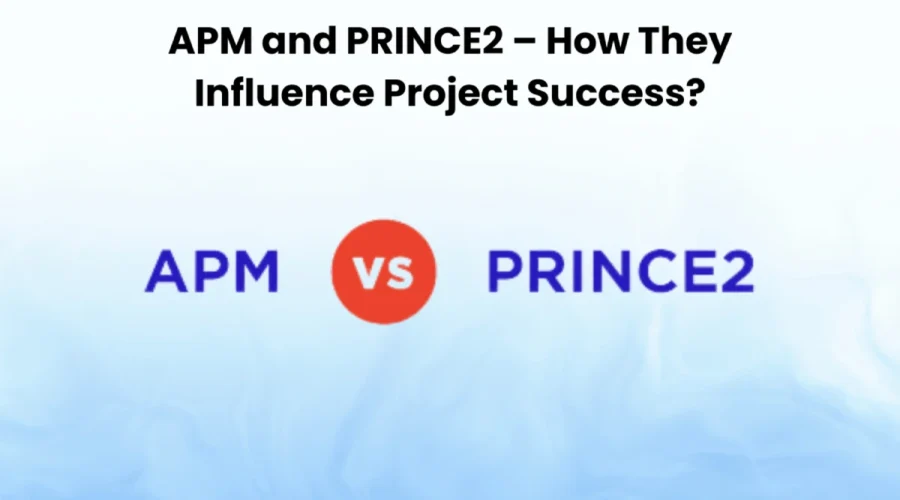Professionals in project management are always looking for approaches that guarantee effectiveness, responsibility, and success. In this context, two well-known frameworks stand out as mainstays: PRINCE2 (PRojects IN Controlled Environments) and APM (Association for Project Management). In this blog, we will examine the applicability of APM Training, the details of APM vs PRINCE2, and how they impact project success.
Table of Contents
- The Significance of APM Training
- APM vs PRINCE2
- The Holistic Approach of APM
- The Structured Governance of PRINCE2
- Harmonising Team Dynamics and Governance
- Precision in Project Planning and Execution
- Enhancing Stakeholder Engagement
- Continuous Improvement through Lessons Learned
- Navigating Complexity with Flexibility
- Integrating APM and PRINCE2 for Project Success
- Striking the Right Balance
- Adapting to Project Context
- Seamless Communication and Collaboration
- Agile Adaptation to Changing Realities
- Robust Risk Management
- Realising Project Success Through APM and PRINCE2
- APM in Nurturing Project Teams
- PRINCE2 in Ensuring Governance and Control
- Conclusion
The Significance of APM Training
Let’s first discuss the value of APM training before delving into the APM vs. PRINCE2 controversy. The mission of APM as an organisation is to promote project management excellence. APM training gives professionals the abilities and know-how needed to successfully negotiate the complexity of contemporary projects.
APM training provides an organised route to improving your project management abilities, regardless of your experience level. APM courses give students a thorough overview of project management best practices, covering everything from basic concepts to sophisticated tactics.
APM vs PRINCE2
Let’s now examine the dynamic interaction between PRINCE2 and APM. Rather than being perceived as competitors, these frameworks are complementary methods that, when thoughtfully used, improve the ecology of project management.
The Holistic Approach of APM
APM takes a comprehensive approach, highlighting the technical facets of project management and the vital role that stakeholders and people play. APM’s emphasis on leadership, soft skills, and stakeholder involvement distinguishes it. When comparing APM to PRINCE2, APM emphasises developing a collaborative team environment and a healthy project culture.
The Structured Governance of PRINCE2
Conversely, PRINCE2 is praised for its process-driven methodology and organised governance. It guarantees that projects are carried out precisely by offering a framework with clearly defined responsibilities, procedures, and templates. PRINCE2 is especially useful for large and complicated projects because of its capacity to provide a scalable and consistent methodology.
Harmonising Team Dynamics and Governance
APM and PRINCE2 work well together when team dynamics and structured governance are balanced. PRINCE2’s governance architecture is enhanced by APM’s emphasis on interpersonal skills, which guarantees that project teams function as a cohesive unit in addition to following procedures. This integration creates an atmosphere where both factors contribute to the project’s success by preventing the people vs process dichotomy.
Precision in Project Planning and Execution
When it comes to offering accuracy in project planning and execution, PRINCE2 shines. PRINCE2’s rigorous approach guarantees that every aspect of a project is carefully planned and carried out from start to finish. When combined with APM’s holistic viewpoint, this accuracy is enhanced by a deep comprehension of the human variables that might affect project results, leading to a well-rounded and successful project.
Enhancing Stakeholder Engagement
PRINCE2 provides a systematic framework for engaging stakeholders, but APM adds sophistication by emphasising the human factor. Combining the two ensures that stakeholder engagement transcends conventional communication strategies and that APM’s insights are applied to developing deep connections. This methodology satisfies PRINCE2’s governance standards and advances APM’s goal of developing projects that engage and truly benefit stakeholders.
Continuous Improvement through Lessons Learned
Learning from experiences is essential and is acknowledged by both PRINCE2 and APM. By combining these approaches, a solid framework for ongoing development is produced. When combined with PRINCE2’s systematic approach to documenting lessons learned, APM’s emphasis on reflection and learning from every project guarantees that every project serves as a stepping stone towards organisational excellence.
Navigating Complexity with Flexibility
The combination of APM and PRINCE2 gives project managers a versatile toolkit to handle changing project complexity. Project managers may negotiate the complexities of different projects with the help of PRINCE2’s structured approach and APM’s flexibility to changing project environments. This adaptability guarantees that the approaches are successful instruments rather than inflexible frameworks.
Integrating APM and PRINCE2 for Project Success
Striking the Right Balance
Project managers frequently achieve success by combining the best features of PRINCE2 and APM into a blended strategy. They achieve this by striking a compromise between the process-driven characteristics of PRINCE2 and the people-centric philosophy of APM. Through this integration, initiatives are guaranteed to meet both technical requirements and the human dynamics that affect their success.
Adapting to Project Context
In project management, there is no one-size-fits-all solution. Project managers can customise their strategy according to the particular needs of each project thanks to the flexibility of APM and PRINCE2. APM gives the flexibility needed to handle the more delicate parts of project management, whereas PRINCE2 offers the discipline required for methodical execution.
Seamless Communication and Collaboration
Project teams may collaborate more effectively and communicate more easily when APM and PRINCE2 are integrated. PRINCE2’s established communication protocols and APM’s emphasis on interpersonal skills combine to create an environment where information flows effectively. This combination reduces miscommunication, fosters better teamwork, and guarantees that project objectives are continuously recognised and followed.
Agile Adaptation to Changing Realities
Project managers can adjust to shifting project realities with greater agility when APM and PRINCE2 are integrated. PRINCE2’s emphasis on flexibility is enhanced by APM’s focus on responsiveness to change and continual improvement. This dynamic combination keeps projects on track for success by enabling teams to overcome unforeseen obstacles and seize new possibilities.
Robust Risk Management
Combining APM and PRINCE2 improves the project manager’s capacity to apply adequate risk management techniques. When combined with PRINCE2’s structured risk identification and mitigation processes, APM’s proactive approach to risk creates an effective barrier against future setbacks. This integrated strategy guarantees the project’s overall resilience and success by anticipating, effectively managing, and mitigating risks.
Realising Project Success Through APM and PRINCE2
APM in Nurturing Project Teams
A project manager with APM training knows the complex balance between interpersonal dynamics and technical expertise. APM greatly enhances team cohesion by promoting a positive project culture, emphasising communication, and giving team members authority. A motivated and engaged team’s capacity to utilise their combined strength is typically the key to successful project outcomes.
PRINCE2 in Ensuring Governance and Control
PRINCE2 outperforms APM by offering a framework that guarantees governance and control. Professionals with PRINCE2 training are skilled at managing risks, developing project strategies, and keeping lines of communication open with stakeholders. This methodical technique reduces uncertainty and improves project outcome predictability.
Conclusion
In project management, APM and PRINCE2 are seen as a dynamic team rather than rivals. APM enhances the formal governance of PRINCE2 by focusing on team dynamics. By arming yourself with PRINCE2 and APM concepts, you can better negotiate challenging situations and lead projects to unquestionable success. Adopt these approaches, as the secret to realising the full potential of excellent project management is their seamless combination.

